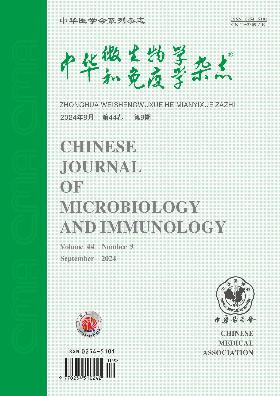花粉季节花粉热患儿外周II型固有淋巴细胞亚群的动态变化及其临床意义
Q4 Immunology and Microbiology
引用次数: 0
摘要
目的分析花粉季节花粉热患儿外周Ⅱ型先天性淋巴细胞(ILC2)亚群表达、功能及信号转导子和转录激活子(STAT6)活性的动态变化。方法对10例花粉热患者、10例屋尘螨(HDM)致敏哮喘患者和12例健康对照(HC)进行研究。通过流式细胞术检测花粉季节内外外周ILC2和Th2相关细胞因子的细胞内表达的变化。从各组中分离外周Lin细胞群,并在IL-25或IL-33存在下培养7d。通过ELISA测定培养上清液中IL-5和IL-13的浓度。通过蛋白质印迹定量磷酸化-STAT6在蛋白质水平上的表达。结果花粉季节花粉热患儿外周ILC2细胞百分率[(23.09±7.86)%]明显高于HDM致敏哮喘患儿[(6.84±3.85)%,P<0.05]和健康儿童[(1.69±0.87)%,P<0.01],但仍高于HDM致敏哮喘组[(3.76±1.96)%,P<0.05]和HC组[(1.32±0.91)%,P<0.01]。花粉季节花粉热患儿外周血IL-13+ILC2细胞[(6.94±3.16)%vs(4.17±1.98)%,P<0.05]和HDM致敏哮喘患者外周血白细胞介素13+ILC2细胞]显著高于非花粉季节。在用IL25或IL-33体外刺激后,花粉热和HDM致敏哮喘儿童的培养上清液中的IL-5和IL-13水平均升高,并且当IL25和IL-33联合使用时观察到协同作用。同时,在花粉热组中,IL25和IL-33刺激后,林细胞中磷酸化-STAT4的蛋白水平显著上调。结论花粉季节花粉热患儿ILC2亚群数量和功能异常可能是导致临床症状短时间出现或急性加重的另一原因。关键词:干草热;屋尘螨;蒿属;信号转导子和转录激活子6;Ⅱ型先天性淋巴细胞本文章由计算机程序翻译,如有差异,请以英文原文为准。
Dynamic changes in peripheral type II innate lymphoid cell (ILC2) subpopulation and its clinical significance in children with hay fever during the pollen season
Objective
To analyze the dynamic changes in the expression and function of peripheral type Ⅱ innate lymphoid cell (ILC2) subpopulation and the activity of signal transducers and activators of transcription (STAT6) in children with hay fever during pollen season.
Methods
A total of 10 patients with hay fever, 10 patients with house dust mite (HDM)-sensitized asthma and 12 healthy controls (HC) were enrolled in this study. Changes in peripheral ILC2 and the intracellular expression of Th2-related cytokines were detected by flow cytometry during and outside the pollen season. Peripheral Lin- cell population was isolated from each group and cultured with the presence of IL-25 or IL-33 for 7 d. The concentrations of IL-5 and IL-13 in culture supernatants were measured by ELISA. Expression of phospho-STAT6 at protein level was quantified by Western blot.
Results
Within the pollen season, the percentage of peripheral ILC2 cells was significantly higher in children with hay fever [(23.09±7.86)%] than in children with HDM-sensitized asthma [(6.84±3.85)%, P<0.05] and healthy children[(1.69±0.87)%, P<0.05]. In the non-pollen season, the peripheral ILC2 cells in children with hay fever presented a decreasing trend [(11.30±2.45)%], but was still higher than that in HDM-sensitized asthmatics [(3.76±1.96)%, P<0.05] and HC [(1.32±0.91)%, P<0.05] at the same time point. Moreover, peripheral IL-13+ ILC2 cells in children with hay fever [(6.94±3.16)% vs(4.17±1.98)%, P<0.05] and in HDM-sensitized asthmatics [(1.89±0.70)% vs(1.44±0.55)%, P<0.05] during the pollen season were significantly higher than those in the non-pollen season. After the in vitro stimulation with IL25 or IL-33, the levels of IL-5 and IL-13 in culture supernatants were both increased in children with hay fever and HDM-sensitized asthmatics, and a synergistic action was observed when IL25 and IL-33 were used in combination. Meanwhile, the protein level of phospho-STAT4 in Lin- cells was significantly up-regulated in the hay fever group after stimulation with IL25 and IL-33.
Conclusions
During the pollen season, the abnormal number and function of ILC2 subpopulation in children with hay fever might be another cause of the occurrence of clinical symptoms in a short period of time or acute exacerbation.
Key words:
Hay fever; House dust mite; Artemisia; Signal transducer and activator of transcription 6; Type Ⅱ innate lymphocyte cells
求助全文
通过发布文献求助,成功后即可免费获取论文全文。
去求助
来源期刊

中华微生物学和免疫学杂志
Immunology and Microbiology-Virology
CiteScore
0.50
自引率
0.00%
发文量
6906
期刊介绍:
Chinese Journal of Microbiology and Immunology established in 1981. It is one of the series of journal sponsored by Chinese Medical Association. The aim of this journal is to spread and exchange the scientific achievements and practical experience in order to promote the development of medical microbiology and immunology. Its main contents comprise academic thesis, brief reports, reviews, summaries, news of meetings, book reviews and trends of home and abroad in this field. The distinguishing feature of the journal is to give the priority to the reports on the research of basic theory, and take account of the reports on clinical and practical skills.
 求助内容:
求助内容: 应助结果提醒方式:
应助结果提醒方式:


